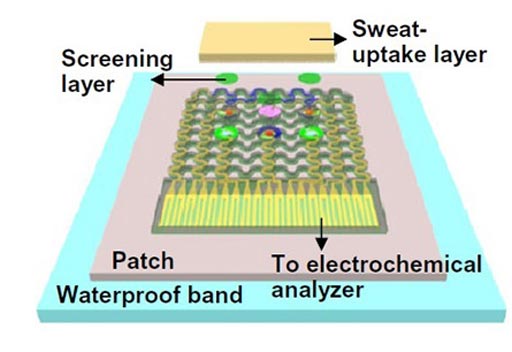Wearable Glucose Device Includes Drug-Delivery Module
By LabMedica International staff writers
Posted on 24 Mar 2017
Researchers have developed a convenient accurate sweat-based glucose monitoring and maintenance device that provides rapid glucose measurement and allows doctors to prescribe a multistep precisely controlled dosage of drugs.Posted on 24 Mar 2017
The research group, from the Center for Nanoparticle Research of the Institute for Basic Science, has furthered its previous study (2016) by enhancing the efficiency of the sweat collection, sensing, therapy processes. The glucose measurement system also comes in a convenient disposable strip-sensor format.

Image: A diagram of the wearable sweat-monitoring patch. A porous sweat-uptake layer is placed on a Nafion layer and sensors (Photo courtesy of the Institute for Basic Science).
The conventional protocol causes high stress to diabetes patients as it requires painful, repetitive blood-withdrawal and insulin shots. Many patients become reluctant to take the required periodic tests and treatments, resulting in worsened symptoms. The recent alternative approach of sweat-based monitoring offers a painless blood glucose monitoring method. However, many challenges for clinical application include: tedious blood collection procedure, error-prone enzyme-based glucose sensing that may lead to overtreatment of drugs, etc.
To address such issues, the research group developed an easy-to-use multistage module. To speed up the sweat collection, they revised the system to work under a low volume of sweat. In the glucose and pH sensors, the reference and counter electrodes are closely packed to minimize the required amount of sweat. The device features more sensors of a smaller size than the previous study, resulting in a miniaturized sensor that allows for reliable analysis even with 1 µl of sweat.
"It was quite a challenge to find the optimal size of the sensors. If the size is too small, the signal becomes too small or the surface functionalization becomes difficult to handle," said study first-author Dr. Hyunjae Lee.
They used electrochemically active, porous metal electrodes (replacing the graphene materials of the previous study) to enhance sensitivity. Also, the porous structure allows it to form strong linkage among enzymes, resulting in increased reliability of sensors under mechanical friction and deformation.
For more accurate reading and feedback therapy, the patch system incorporates an additional sweat uptake layer (water-soluble and porous carbohydrate network to efficiently absorb the sweat exuding from skin) and a waterproof band behind the silicone patch facilitates sweat collection and keeps the patch intact even under physical deformation of the skin.
The system also enables reliable drug delivery to prevent overtreatment. Drugs for the feedback therapy are loaded on two different temperature-responsive phase change nanoparticles (PCNs) embedded in microneedles, which are additionally coated with phase change materials (PCMs).
Dr. Lee underscores the role of the additional PCM spray coating: "The previous systems cannot prevent natural diffusion of the drugs from drug reservoir, and rely heavily upon elevation of temperature to enhance the rate of drug diffusion. Our system uses PCMs to prevent drug release by using the melting properties of phase change materials above critical temperature, enabling stepwise drug delivery. Furthermore, different drugs can also be loaded in PCNs for stepwise and multiple drug delivery."
The thermo-responsive microneedles controlled by three multichannel heaters can deliver a drug up to 6 steps of dosages in response to the measured glucose level. In experiments with diabetic mice, the researchers confirmed that as more drug is delivered, the blood glucose level is further suppressed.
"This convenient and accurate system is also compatible for mass-production as it uses the metal electrode that can be easily fabricated via a conventional semiconductor fabrication process," said Dr. Lee, though “there is still room for improvement before [...] clinical application." Co-corresponding author KIM Dae-Hyeong noted, "The fundamental mechanism underlying this system can be applied in the diagnosis and clinical treatments of various diseases.”
The study, by Lee H et al, was published March 8, 2017, in the journal Science Advances.













